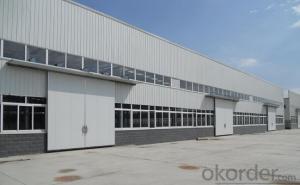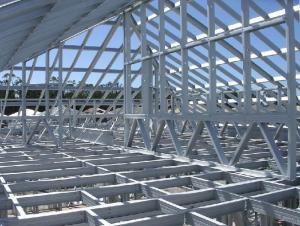Heavy steel Workshop
- Loading Port:
- Tianjin Port
- Payment Terms:
- TT or LC
- Min Order Qty:
- 10000 sqare meters m.t.
- Supply Capability:
- 50000 Square Meters/Month m.t./month
OKorder Service Pledge
OKorder Financial Service
You Might Also Like
Specifications of heavy steel workshop
The project is smelting heavy steel workshop
Maximum crane: 100 tons
Single building area: 30,000 square meters
1. GB standard material
2. High Structural safety and reliability
3. The production can reach GB/JIS/ISO/ASME standard
Packaging & Delivery of heavy steel workshop
1. According to the project design and the component size, usually the main component parts are nude packing and shipped by bulk vessel. And the small parts are packed in box or suitable packages and shipped by containers.
2. This will be communicated and negotiated with buyer according to the design.
Engineering Design Software of heavy steel workshop
Tekla Structure \ AUTO CAD \ PKPM software etc
⊙Complex spatial structure project detailed design
⊙Construct 3D-model and structure analysis. ensure the accuracy of the workshop drawings
⊙Steel structure detail ,project management, automatic Shop Drawing, BOM table automatic generation system.
⊙Control the whole structure design process,we can obtain higher efficiency and better results
Technical support of heavy steel workshop
|
Worker |
Rate of frontline workers with certificate on duty reaches 100% |
|
Welder |
186 welders got AWS & ASME qualification 124 welders got JIS qualification 56 welders got DNV &BV qualification |
|
Technical inspector |
40 inspectors with UT 2 certificate 10 inspectors with RT 2 certificate 12 inspectors with MT 2 certificate 3 inspectors with UT3 certificate |
|
Engineer |
21 engineers with senior title 49 engineers with medium title 70 engineers with primary title. 61 First-Class Construction Engineers 182 Second-Class Construction Engineers |
|
International certification |
10 engineers with International Welding engineer, 8 engineers with CWI. |
Production Flow of heavy steel workshop
Material preparation—cutting—fitting up—welding—component correction—rust removal—paint coating—packing—to storage and transportation (each process has the relevant inspection)
steel structure cutting machine steel structure (H beam) fitting up machine steel structure welding machine steel structure painting area
Usage/Applications of steel structure/steel frame

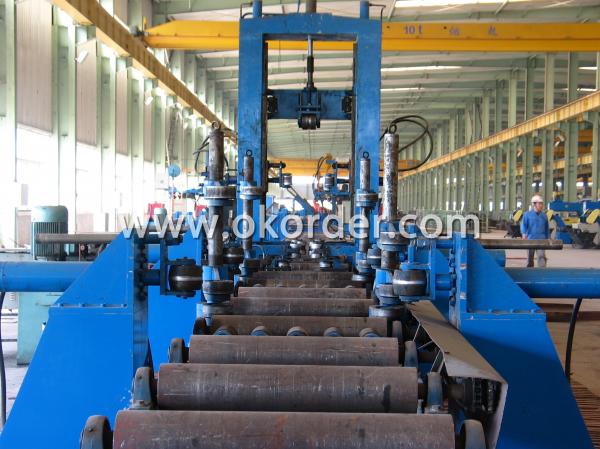
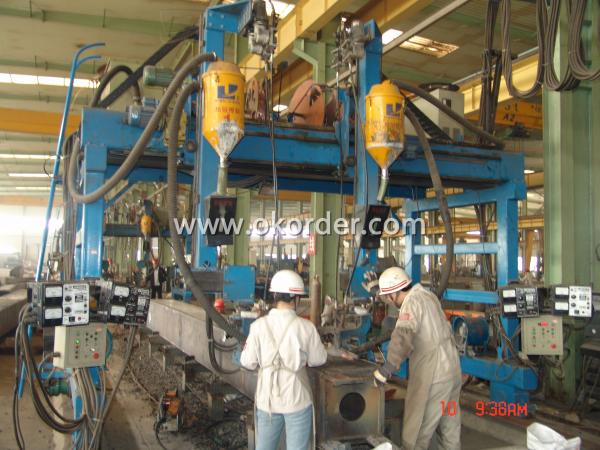
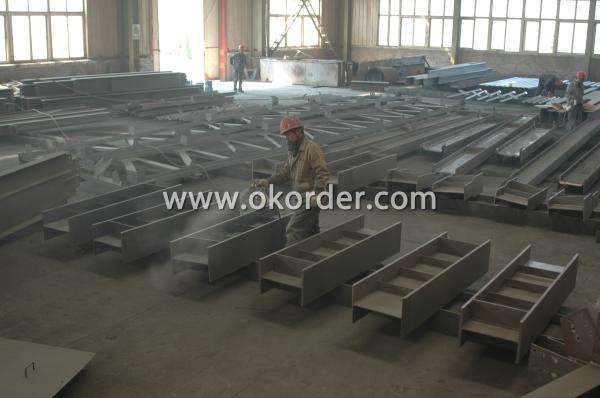
*Characters of Structure Steel
1. Steel is characterized by high strength, light weight, good rigidity, strong deformation capacity, so it is suitable for construction of large-span, super high and super-heavy buildings particularly;
2. It with good homogeneous and isotropic, is an ideal elastomer which perfectly fits the application of general engineering;
3. The material has good ductility and toughness, so it can have large deformation and it can well withstand dynamic loads;
4. Steel structure’s construction period is short;
5. Steel structure has high degree of industrialization and can realize-specialized production with high level of mechanization.
*Steel structure application
1. Heavy industrial plants: relatively large span and column spacing; with a heavy duty crane or large-tonnage cranes; or plants with 2 to 3 layers cranes; as well as some high-temperature workshop should adopt steel crane beams, steel components, steel roof, steel columns, etc. up to the whole structure.
2. Large span structure: the greater the span of the structure, the more significant economic benefits will have by reducing the weight of the structure
3. Towering structures and high-rise buildings: the towering structure, including high-voltage transmission line towers, substation structure, radio and television emission towers and masts, etc. These structures are mainly exposed to the wind load. Besides of its light weight and easy installation, structure steel can bring upon with more economic returns by reducing the wind load through its high-strength and smaller member section.
4. Structure under dynamic loads: As steel with good dynamic performance and toughness, so it can be used directly to crane beam bearing a greater or larger span bridge crane
5. Removable and mobile structures: Structure Steel can also apply to movable Exhibition hall and prefabricated house etc by virtue of its light weight, bolt connection, easy installation and uninstallation. In case of construction machinery, it is a must to use structure steel so as to reduce the structural weight.
6. Containers and pipes: the high-pressure pipe and pipeline, gas tank and boiler are all made of steel for the sake of its high strength and leakproofness
7. Light steel structure: light steel structures and portal frame structure combined with single angle or thin-walled structural steel with the advantages of light weight, build fast and steel saving etc., in recent years has been widely used.
8. Other buildings: Transport Corridor, trestle and various pipeline support frame, as well as blast furnaces and boilers frameworks are usually made of steel structure.
All in all, according to thereality, structure steel is widely used for high, large, heavy and light construction.
- Q:What are the different types of steel columns used in construction?
- Some of the different types of steel columns used in construction include H-shaped columns, I-shaped columns, box columns, and circular columns.
- Q:How are steel structures used in the construction of concert halls?
- Steel structures are commonly used in the construction of concert halls as they provide the necessary strength and support to accommodate large open spaces, heavy equipment, and intricate architectural designs. Steel beams and columns are used to create the framework of the building, allowing for long spans and high ceilings. Additionally, steel is fire-resistant, which ensures the safety of the concert hall and its occupants. Overall, steel structures play a crucial role in creating durable, versatile, and visually appealing concert halls.
- Q:What does nonstandard steel structure mean?
- There are non-standard and national standards, non-standard is a more special component, not conventional components,
- Q:How are steel structures used in the construction of planetariums?
- Steel structures are commonly used in the construction of planetariums due to their durability, strength, and versatility. These structures provide the necessary framework to support the unique design and functionality of a planetarium. One of the main uses of steel structures in planetariums is to create the dome shape that is characteristic of these buildings. The dome shape is essential for projecting the immersive astronomical visuals onto the interior surface. Steel allows for the construction of large, curved surfaces that can withstand the forces exerted by the weight of the dome and the projection equipment. Moreover, steel structures are used to support other elements within the planetarium. For example, steel beams can be used to support the seating areas, walkways, and observation decks. Steel columns and beams provide the necessary strength to bear heavy loads and ensure the safety of visitors. Steel structures also play a crucial role in ensuring the stability and structural integrity of the planetarium. They can be designed to withstand various environmental factors, such as wind, earthquakes, and snow loads, making the building safe and long-lasting. Furthermore, steel is a versatile material that allows for flexibility in design. It can be fabricated into different shapes and sizes, enabling architects to create unique and aesthetically pleasing structures. This is particularly important in planetariums, where the building's design often aims to evoke a sense of wonder and exploration. In summary, steel structures are integral to the construction of planetariums, providing the necessary strength, stability, and versatility required for these unique buildings. From creating the iconic dome shape to supporting various elements within the structure, steel plays a vital role in ensuring the success of a planetarium project.
- Q:What are the design considerations for steel airports?
- Some of the key design considerations for steel airports include the structural integrity and strength of the steel framework, the ability to withstand extreme weather conditions, the incorporation of efficient and flexible space planning, the integration of sustainable and energy-efficient systems, and the aesthetic appeal of the airport design. Additionally, factors such as ease of construction, durability, and cost-effectiveness also play a crucial role in the design considerations for steel airports.
- Q:How are steel structures used in the construction of casinos?
- Casinos often opt for steel structures due to their numerous benefits. The primary use of steel in casino construction is for the building's framework. The high strength-to-weight ratio of steel allows for the creation of large and spacious areas without the need for excessive support columns or walls. This open design is essential for incorporating vast gaming areas, grand entrances, and atriums. Moreover, steel's durability and resistance to fire, earthquakes, and other natural disasters make it an excellent material for casino construction. Given the high occupancy load and the need for robust structures capable of withstanding heavy loads and potential hazards, steel structures provide the necessary strength and stability to ensure the safety of the building and its occupants. Additionally, the versatility of steel enables architects to create innovative designs, resulting in the iconic and extravagant exteriors often associated with casinos. Steel can be easily shaped, fabricated, and manipulated to form unique shapes, curves, and facades. These distinct designs not only make a visual impact but also enhance the overall experience for casino visitors. Furthermore, steel structures offer the flexibility to accommodate future expansions or modifications, which is crucial in an industry that is constantly evolving. Steel allows for easier alteration and addition of new sections without compromising the overall structural integrity. In conclusion, steel structures are integral to the construction of casinos. Their strength, durability, versatility, and adaptability make them the ideal choice for creating the open, grand, and visually striking spaces that are synonymous with the world of casinos.
- Q:How are steel structures designed to accommodate security or access control systems?
- Steel structures can be designed to accommodate security or access control systems by incorporating features such as reinforced walls, doors, and windows, as well as integrating wiring and infrastructure to support surveillance cameras, alarms, and access control devices. These structures are often planned with specific locations for mounting security equipment and ensuring that the structural elements do not obstruct the functionality of the security systems. Additionally, steel structures can be designed to meet certain security standards, such as blast resistance or bulletproofing, to ensure enhanced protection.
- Q:What are the advantages of using steel in the construction of healthcare facilities?
- There are several advantages of using steel in the construction of healthcare facilities. Firstly, steel is a highly durable material that can withstand heavy loads and extreme weather conditions, ensuring the long-term stability and safety of the building. Secondly, steel is fire-resistant, which is crucial for healthcare facilities where the safety and protection of patients is of utmost importance. Additionally, steel is a flexible material that allows for versatile design options, enabling architects to create functional and aesthetically pleasing healthcare spaces. Moreover, steel construction is time-efficient as it allows for faster construction cycles, reducing downtime and enabling healthcare facilities to be operational sooner. Lastly, steel is a sustainable and eco-friendly building material, as it is recyclable and has a low carbon footprint, aligning with the growing demand for environmentally conscious construction practices.
- Q:What is the role of steel in industrial buildings?
- Due to its exceptional strength, durability, and versatility, steel plays a crucial role in the construction of industrial buildings. It is the preferred material for structural support systems in such buildings for various reasons. First and foremost, steel's high tensile strength allows it to withstand heavy loads and resist the forces exerted on the building. This strength enables the construction of large open spaces without the need for excessive columns or support walls, maximizing the usable floor area and allowing for flexible layouts. Additionally, steel is highly durable and resistant to corrosion, weathering, and pests. This makes it ideal for withstanding the harsh conditions often found in industrial environments, including extreme temperatures, humidity, and chemical exposure. Compared to other materials, steel structures have a longer lifespan, reducing maintenance and replacement costs over time. Moreover, steel is lightweight, making it easier and more cost-effective to transport and erect on-site. Its prefabricated nature allows for efficient and swift construction, minimizing labor costs and disruption to ongoing operations. Furthermore, steel enables the implementation of sustainable design principles in industrial buildings. It is a highly recyclable material that reduces the need for other construction materials with a larger environmental footprint, such as concrete or wood. Additionally, steel structures can be designed to be energy-efficient by incorporating features like insulation, natural lighting, and renewable energy systems. Lastly, steel's versatility allows for the design of complex and innovative industrial buildings. It can be easily molded and fabricated into various shapes and sizes, enabling architects and engineers to create visually appealing and unique structures. Steel can also be integrated with other building materials, like glass or concrete, to further enhance the aesthetic and functional aspects of the industrial building. In conclusion, steel's role in industrial buildings is fundamental, providing the necessary strength, durability, and versatility to support the structural framework and withstand harsh conditions. Its numerous advantages make it the preferred choice for industrial building projects, contributing to their safety, longevity, and overall functionality.
- Q:What are the considerations for designing steel structures in cold climates?
- In the design of steel structures in cold climates, it is important to take several factors into account in order to ensure the safety, durability, and efficiency of the structure. Some key considerations are as follows: 1. Proper selection of materials is crucial in cold climates. It is preferable to use high-strength steel with good toughness properties to withstand low temperatures and potential impact loads. Furthermore, the steel should have excellent resistance to corrosion, as cold climates often involve exposure to moisture, snow, and deicing chemicals. 2. In cold climates, insulation is essential to prevent thermal bridging. Thermal bridging occurs when heat is transferred through the steel structure at a faster rate than through the insulation, resulting in energy loss and potential condensation problems. The design should incorporate insulation materials with low thermal conductivity and ensure the insulation layers are continuous to minimize heat transfer. 3. Structural design must take into account the additional loads imposed by cold climates, such as snow accumulation, ice formation, and wind forces. Structural members should be designed to accommodate these increased loads, taking into consideration factors such as snow load, ice buildup, and wind speed specific to the region. Special attention should be paid to the design of connections, as they can become more brittle in cold temperatures. 4. Foundations in cold climates need to be designed to withstand freezing and thawing cycles. Proper insulation and frost protection measures, such as incorporating insulation boards or heating elements, can prevent frost heave and maintain the integrity of the foundation. 5. Ventilation and moisture control are important in cold climates, as they can lead to high humidity levels inside buildings due to heating systems and temperature differentials. Adequate ventilation and moisture control measures, such as vapor barriers and sufficient air exchange, should be implemented to prevent condensation, mold growth, and corrosion of steel components. 6. Regular maintenance is crucial for steel structures in cold climates in order to ensure their longevity. This includes regular inspections to identify signs of corrosion, ice damming, and damage caused by freeze-thaw cycles. Prompt repairs, such as coating damaged areas and removing ice buildup, should be carried out to prevent further deterioration. By considering these factors, engineers can design steel structures that are resilient, energy-efficient, and capable of withstanding the unique challenges presented by cold climates.
1. Manufacturer Overview |
|
|---|---|
| Location | SHANDONG,China |
| Year Established | 2008 |
| Annual Output Value | Above US$20 Billion |
| Main Markets | WEST AFRICA,INDIA,JAPAN,AMERICA |
| Company Certifications | ISO9001:2008;ISO14001:2004 |
2. Manufacturer Certificates |
|
|---|---|
| a) Certification Name | |
| Range | |
| Reference | |
| Validity Period | |
3. Manufacturer Capability |
|
|---|---|
| a)Trade Capacity | |
| Nearest Port | TIANJIN PORT/ QINGDAO PORT |
| Export Percentage | 0.6 |
| No.of Employees in Trade Department | 3400 People |
| Language Spoken: | English;Chinese |
| b)Factory Information | |
| Factory Size: | Above 150,000 square meters |
| No. of Production Lines | Above 10 |
| Contract Manufacturing | OEM Service Offered;Design Service Offered |
| Product Price Range | Average, High |
Send your message to us
Heavy steel Workshop
- Loading Port:
- Tianjin Port
- Payment Terms:
- TT or LC
- Min Order Qty:
- 10000 sqare meters m.t.
- Supply Capability:
- 50000 Square Meters/Month m.t./month
OKorder Service Pledge
OKorder Financial Service
Similar products
New products
Hot products
Related keywords





















